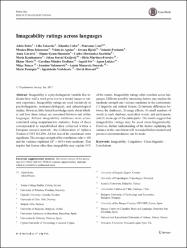Imageability ratings across languages

Göster/
Erişim
info:eu-repo/semantics/openAccessTarih
2018Yazar
Rofes, AdriaZakarias, Lilla
Ceder, Klaudia
Lind, Marianne
Johansson, Monica Blom
de Aguiar, Vania
Varlokosta, Spyridoula
Üst veri
Tüm öğe kaydını gösterÖzet
Imageability is a psycholinguistic variable that indicates how well a word gives rise to a mental image or sensory experience. Imageability ratings are used extensively in psycholinguistic, neuropsychological, and aphasiological studies. However, little formal knowledge exists about whether and how these ratings are associated between and within languages. Fifteen imageability databases were cross-correlated using nonparametric statistics. Some of these corresponded to unpublished data collected within a European research network-the Collaboration of Aphasia Trialists (COST IS1208). All but four of the correlations were significant. The average strength of the correlations (rho = .68) and the variance explained (R (2) = 46%) were moderate. This implies that factors other than imageability may explain 54% of the results. Imageability ratings often correlate across languages. Different possibly interacting factors may explain the moderate strength and variance explained in the correlations: (1) linguistic and cultural factors; (2) intrinsic differences between the databases; (3) range effects; (4) small numbers of words in each database, equivalent words, and participants; and (5) mean age of the participants. The results suggest that imageability ratings may be used cross-linguistically. However, further understanding of the factors explaining the variance in the correlations will be needed before research and practical recommendations can be made.

















